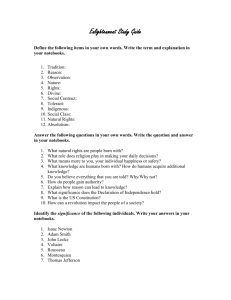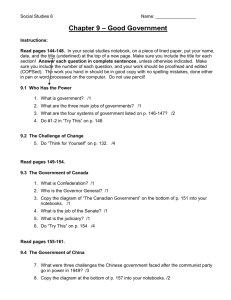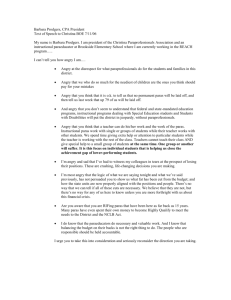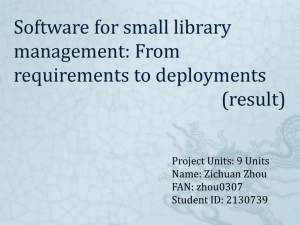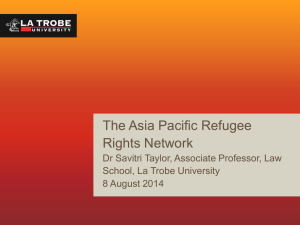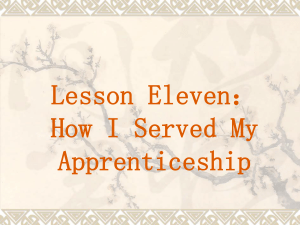Our PB Legacy
advertisement
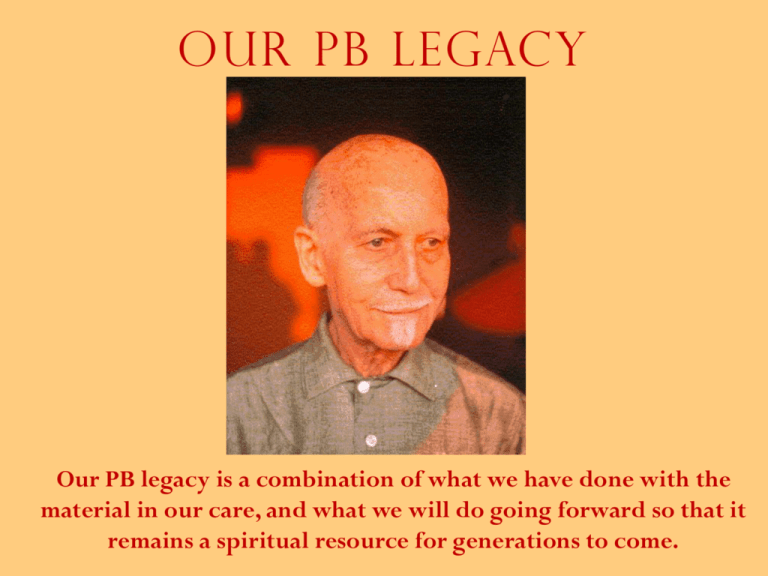
Our PB Legacy Our PB legacy is a combination of what we have done with the material in our care, and what we will do going forward so that it remains a spiritual resource for generations to come. Overview What has been done so far A brief history of creating The Notebooks How it was done How much material did we use? How much is left? Where current projects are What the Archiving Committee and its projects have accomplished to date The Problem of the Two sets of 28 Categories & other problems we face. What’s next What needs to be done to provide access to the remaining material Preservation, Access, Distribution Why this work is essential The Starting Point All the original Hand-bound research volumes (shelves 1, 2, and 5) and the Notebooks (shelves 3, 4, 6 & 7) Phases of Publication and Archiving • Initial organization and publication of the PB material in PB’s Ideas series that became the published Notebooks took a tremendous amount of time and money (details on that to come). • As huge a project as that was, there is still more to do. Now that that phase is finished, we have moved into the next, more longterm process of preservation in order to ensure accessibility and to produce further publications (for example, in the form of ebooks, print books, material published online). • The amount of time and money that is needed for current phases are in line with what came before. • If we take action immediately, the next phase will take between 5 and 15 years (depending on funding), and can secure the PB legacy for generations to come. Let’s take a deeper look… PBs Last years: Preparations for The Notebooks • In 1978 PB began organizing his notes for posthumous publication and study. He first differentiated the “Idea Series” from his Topic Notes, Book Notes, and Miscellanea. Ed McKeown helped him do this. • In 1979 PB decided to re-organize the Idea series from his personal choice of 28 categories into a restructured group of 28 categories that divided, combined and otherwise rearranged the original 28 categories. PB also specified that any material published was to be in the new Category order only. Timothy helped him do this. • PB also made a final review of the changes he wanted made in his earlier publications. Alan (Micha-El) assisted in this project. • In 1980 PB made some refinements to his reclassification in the few months before he died. Randy helped with this. • Shortly after his death, a note was found by Randy (or Kenneth?) that stated that Kenneth was to inherit the literary rights to the books. After PB’s Passing: Creating The Notebooks • In 1981 all of PB’s notebooks arrived by steamer in New York; they were brought to WG and the process of Xeroxing them began. Bo, Randy and Amy did much of this work. • Also in 1981 the work of typing, proofing and creating a database was begun. Anthony oversaw this and established the policy that Randy and Timothy were in charge of any decisions regarding this process and its outcome—and that when they disagreed Randy would have the final say. • Perspectives was produced and the rest of the Notebooks came along over the next 8 years. • More than 40 people were involved with the typing, proofing, data-entry, reclassifying and publication of the Notebooks. All the paras in the volumes identified as the Idea Series were entered into a database, including all those which were not published. Some 14,606 pages were typed, comprising approximately 57,000 paras. Producing The Notebooks • Each and every para was reclassified by this amazing team into the New Categories, and then these were prioritized and the best were published. Every effort was made to represent the proportions of PB’s focus on particular points: thus if he had 100 paras on sunset meditation and 30 on posture, 20 paras on sunset and 6 on posture were published. • Some editing of the original paras was done by a small team. Randy Cash had final and sole say on all edits that were published. Some gender changes were introduced, as well as changes in grammar, rephrasing, and standardization of spelling. • The “Topic Notebooks” or non-Idea series were skimmed for paras that might fit the 28 Categories, but on the whole were left for another day. The remaining Notebooks (like Office Manual, Interviews and Book Notes) were not considered. What It Cost • The man-hours put into creating the Notebooks is probably incalculable, but here’s a guess. • At least 8 people spent most of their week working at least 40 hours for over 7 years. That comes to 112,000 hours of labor. (40 x 50 x 7 x 8) These people included Randy, Amy, Timothy, Dotty Weiner, June, Elaine Mansfield, Jeanne Astor, and Susan Lee Meeder. • At least 25 people spent about 10 hours a week for 7 years classifying, typing, proofing, and just plain keeping track of everything. That comes to 105,000 hours (10 x 50 x 7 x 25). • Putting the two together this makes 217,000 hours spent in creating the database! At $10 an hour… that’s $2,170,000 • The finances came from one major donor (Robert Larson) who, I believe gave some $100,000 to start things up, and from several WG members who, I believe, gave an average of $10,000 per volume = $160,000. The GrandTotal was around $260,000. [Randy is checking these numbers] How We Got from the Originals to The Notebooks 92 Non-Idea Series Notebooks review for possible overlap with Idea Series 92 Non- Idea Series Notebooks put aside. All 124 of the Original Notebooks 32 Idea Series Notebooks prepped for project Some paras marked for typing and added to the Idea-Series Expanded Idea Series ready for work The First Pass Original Notebooks Proofreading Xerox of Notebooks Xeroxes are Typed Vic’s Hard Drive Printout for Cut and Paste Sort Reclassify Paras The Second Pass Printout for Cut and Paste Sort Printout for additional Proofing Pages cut into paras, for reclassification into subheads, ranking and then clipped to pages in a rough order Amended Paras put into Vic’s Hard Drive Amended Paras into Vic’s Hard Drive Again Printout for final Classification & Editing The Final Pass Amended Paras into Vic’s Hard Drive Again Printout for Layout and another Proofing. Paras glued into final order, final edits added and sent off to printer Magic! Actual Books! The End of Phase One: Observations • PB gave very few directions verbally or in writing. He specifically stated that all published material should be organized by the 28 Categories, and that no material from any Category was to be published in a stand-alone fashion. He said that the 28 Categories were to be read in sequence and studied as a whole. • PB did not train anyone in editing nor was any editing of his material presented to him for approval or rejection that I’m aware of. (Randy may know otherwise.) On the other hand PB didn’t forbid it—he just didn’t say anything about it. • PB specifically wanted the material from the Idea Series to be made public. He did not specify the publication or withholding of the remaining material. When Tim asked His Holiness Shankaracarya about these volumes, he was directed to answer the question for himself. Phase Two – Recent activity • Careful (and the first) inventory of all PB materials in hand, including page count, evaluation of the physical state of the item, its topics, and its relative importance. • Scanning all PB material according to modern archival standards. • Conversion of the scans to PDFs, double checking against originals • Cleaning the mold and dirt from the Clips and other secondary material, including the bound books. • Housing and sorting the Clips (print articles from kept by PB—many of which are annotated by him). • Volunteer typing and proofreading of scanned materials. • Computerized comparison of the duplicate images to the original notebooks How much of the unpublished material is worth making available? • Determining quality of the material is a subjective process and there is so much material that it is hard to calculate in advance. A blend of facts and guesstimates is on following slides • The best guess comes from Timothy and the Archiving Committee: Timothy has been reading and going through the material the most, and the Committee has also been reading through it • Input from members of the Archiving Committee • The next set of slides show the context of the Idea Series Notebooks and the four other types of PB notebooks. Methodology • I’ve taken two approaches – evaluating the material by pages and by paras. Both are flawed in that they will be accurate only after the fact, as it is unrealistic to count the paras before starting the process. • PB sometimes used both sides of the page, but most of the time he did not. To account for this, I’ve assumed 80% of the back sides are blank, which means that 40% of the total page count can be subtracted as blank pages. • The exception is the duplicates, which always have blank backs, so they’ve been reduced by 50% at the outset. All page counts are from the pdfs and are only estimates with respect to how many blank pages there are per volume. • I’ve also assumed that there are a little over 6 paras per page in every volume; I got this number by using the para count in several volumes and dividing it by the number of pages in those volumes. Again, there are some pages which have as many as 20 para (phrases) on them, and some which have less than one (essays), but this seems a generally good number for most volumes. The Five Major Classes of Material Proportion by Number of Volumes in Each Class IDEA SERIES Topical Notebooks Duplicates Miscellaneous Book Notes & Interviews The Five Major Classes of Material Class Volumes Percentage Idea Series Notebooks Topic Notebooks Duplicates Miscellaneous Book Notes & Interviews TOTAL NOTEBOOKS 32 24 33 19 16 124 26% 19% 27% 15% 13% 100% Projection of Valuable Paras Left Total Number of Pages in Published Notebooks 6046 Minus 10 pages per volume for front matter etc. -160 Total Pages of Published Paras 5886 Total pages in Idea Series (-40% of blank backs) 8763 Minus Total pages of paras published (60% of the whole) -5258 Total unused valuable paras in the Idea Series 3505 Total pages in Topical Notebooks (-40% of blank backs) 4664 If 40% of these are valuable 1865 Total pages in Duplicates (-50% for all blank backs) 5276 If 50% are these are unused and valuable 2638 Total pages of unused and valuable Paras 8009 Proportion of unused paras to published good paras 136% Meaning there are significantly more good unpublished paras than there are published paras, so we could easily produce another 16 Volumes! Proportions of Valuable Paras Left Guestimates of Valuable Paras by Pages Published Paras Unused Idea Series Paras Unused Valuable Topical Ideas Unused Valuable Duplicate Paras 3 Estimates based on Para counts assuming 6 Paras per page High 50% Avg. 40% Low 30% Number of Unpublished Good Paras in Idea Series 34,408 22,939 15,592 Number of Paras in Topical Notebooks 23,322 11,661 9,328 6,996 Number of Paras in Duplicates 31,000 18,600 12,400 9,300 Total paras unpublished and worthwhile 64,669 44,667 31,888 53% 77% 107% 34,408 paras in Notebooks as percentage of unpublished paras Low Guess on Unused Paras From Idea Series From Topical Notebooks From Duplicates PUBLISHED PARAS Average Guess on Unused Paras From Idea Series From Topical Notebooks From Duplicates PUBLISHED PARAS High Guess on Unused Paras From Idea Series From Topical Notebooks From Duplicates PUBLISHED PARAS The 28 categories, old and new: what happened, what the differences are, and how we can address the problem. The Twenty-Eight Categories: The destroyed database and why reconstituting it is important • PB’s 28 categories that became The Notebooks were from the Ideas series. • He originally had them classified in one order but then re-classified them into 28 very different categories, in a very different sequence. • During the initial organizing for publication after PB’s death, material was classified and prioritized as well as marked if it was published or not. This became the database, that was destroyed. • We have the “monster sort” that can be typed to reconstitute it; if we don’t do that, the material –as much as ten thousand of pages of what was and was not published– will have to be re-classified again, which will take at least 10 years (it took 8 last time, and that was with many people). • If the paras are not reclassified, and they are published, there will be two absolutely different meanings for each Category, and we will be directly ignoring PB’s sole request regarding the publication of his paras. The Twenty-Eight Categories: PB’s personal copy PB had the back trimmed to make it lighter for him to hold! Details on the Changed Categories • PB used 28 Categories throughout his writing career to organize his thoughts. When I asked him if that number was significant, he said yes; when I asked him if it had to do with either 7 (chakras) x 4 (levels of consciousness) or the 28 day lunar cycle, he said no; when I asked him what it did refer to, he said he wouldn’t answer that! • I don’t know how often he rearranged these categories, but the marks on various pages suggests that it happened more than once. He began his final arrangement during our (Devon and I) 7-month stay with him. • During that time PB created an order in which his ideas were to be studied, and so he split or merged various categories to that end. • He said that he wanted these categories to be published intact, and not separated one from another, as all 28 were interlocked and necessary for successful practice of philosophy. Details on the Changed Categories cont. • During my stay, every few days PB would make an adjustment to the categories and I’d type up a new version. • We would then apply this to a selection of paras and he would review the results. • Eventually PB settled on an order and arrangement that he liked, and he began using the new system whenever he wrote up new paras. • The next frame shows how PB finalized the 28 categories from the old classification to the new one. I XIV, XXII Art and Inspiration XV XIX The Reign of Relativity I IV Overview of the Quest XV XXIII The Orient II III Relax and Retreat XVI XXVIII The Absolute Mind II XVII Overview of the Practices Involved XVI XX The Sensitives III IV, XXIII Meditation XVII II, XXIII Way to Overself III II Relax and Retreat XVII XIX The Religious Urge IV I The Path XVIII XXV The God Within IV III, Elementary XVIII XXII The Reverential Life V XX What is Philosophy XIX XVII Religion V VIII The Body XIX XV The Reign of Relativity VI VI Emotions and Ethics XX XVI The Sensitives VI VI Emotions and Ethics XX V What is Philosophy? VII VII The Intellect XXI XXVI The World Idea VII VII The Intellect XXI X Mentalism VIII V The Body XXII XVIII The Reverential Life VIII XI The Ego XXII I, Inspiration XXIII XV Orient and Occident IX XIV From Birth to Rebirth XXIII III, Advanced X XXI Mentalism XXIV XII General X XXVI Healing of the Self XXIV XXVII The Peace Within You XI VIII The Ego XXV XIII Human Experience XI IX The Negatives XXV XVIII WorldMind in Individual Mind XII XXII The Overself XXVI X Mind-Body in Health & Sickness XII XXIV Reflections XXVI XXI The World Idea XIII XXVII The World Mind XXVII XXIV The Peace Within XIII XXV Human Experience XXVII XIII The World Mind XIV IX From Birth to Rebirth XXVIII IV Practices for the Quest XIV I The Arts in Culture XXVIII XVI The Absolute Mind IX XI The Negatives XXVIII Meditation XII and the Overself XVII Contemplation The Monster Sort • The Monster Sort is a printout of the first line of every para that was in the database. Each para is identified by a Volume/page/paragraph which is anomalous, and has the new category classification on it, together with notation that tells us whether it was published or not, whether Anthony marked it or not, and other details. • If this was keyboarded it could be used as a database which a program could use to match the first line to the newly typed paras and thus reunite the new category to the para, and immediately identify it as published or not. • This program can be written by David Shumway, and should be fairly accurate. It’s only ‘fairly accurate’ because: • There are many problems with typos in the Monster Sort and its overall accuracy will have to be spot checked, but this is a process we can set in motion without a massive outlay of cash. Why we need to keyboard the material • There is so much valuable material and it’s important to preserve and publish it, not only for people alive now but for the long-term • Once keyboarded material can be searched, annotated, and edited for consistency (spelling of proper names) or for security (deleting sensitive statements) • The .pdf scans in this case are pictures, not documents and cannot be searched (see OCR example for explanation) • The .tiff files are archival quality, but massive, literally 20 times larger than the pdf files, and are more than 3 TB of data. They cannot be searched, but can be converted to a variety of other file types – including .pdf and Photoshop files. • Keyboarding is a necessary step for any publication as e-book or even as a document to be searched in a specific library. Why not OCR? • OCR (Optical Character Reading) simply doesn’t cut it with the PB material. • OCR can usually be done as a document is being scanned or after the fact. • We use the latest version of Acrobat (and Omnipage Pro and ABBYY Reader) and test the scans about every six months – whenever a new version of one of these comes out. • Invariably, to date, they produce garbage or a multitude of small but significant problems which are more time consuming to fix than typing the document is (this has been timed and tested). • Errors include extra spaces between words which will crash searches on phrases, extra or absent punctuation, • Errors that won’t be caught by the spell checker include wild guesses at words that are words but incorrect, capitalization errors, the inse5rtion (inserrtion) of a non-alphabetical character. Numbers that are easily misread like 5 and 6, or making a 1 an l and vice-versa. • Two sample pages typical of ‘good’ and ‘bad’ PB pages follow with their respective OCR output. ( ) There are s trange (ATLANTIS') inscriptions in Y ucatan which baffle archeologists: mysterious hieroglyphs which may one day be deciphered and prove the Rosetta stone ,- of Atlantean civilization. Engraved on monu-- -«nts, carved into temple walls, they may give crorroboration and detail to the tale of Atlantis which Solon heard in the temples of Egypt. ( ) There exists and has been found an early writing of the Yucatan Mayas, "The Troana Codex" as scholars name it, which tells that ten countries were sunk, carrying sixty million inhabitants into the realm of death. It confirms Plato's statement of ten kingdoms in Atlantis, and ten islands mentioned by Marcellus, an ancient historian, as existing in the Atlantic ocean. The Forth American Indian tribes have a general tradition that there was a great deluge which drowned most of mankind. "The migrations of Atlantean peoples explain f~ the striking similarities in the hieroglyphs of Egypt, Annam and even China, in the East, and Mayan writing in the West." ( } The Noah of the Bible becomes the Pami of the Hindus, but the fact of the Deluge remains the ssjse; in China he becomes Na-Oua, but the Flood story i£ toM there, too. Frora the Fiji Island, to Mexico we find versions of the same story, varying in details but agreeing in the one essential fact -a universal deluge. The Chaldean historian, Berosus, gives a similar story to that of the Flood, in Genesis, which he tells us he copied from the ancient libraries of his land.. Where forgotten races lived A vast tremor shook the continent ( ) The adepts transferred the White ijodge from Atlantis to Egypt more than 200,000 years ago, seeking peace and freedom from the undesirable influences of Atlantis, say Theoso__ ) But catastrophe ?;as pending and the Guides prepared a selected fev;, about 10,000 souls-a chosen race-to leave Atlantis about 80,000 B.C. and sail across the vast Sksmx Sahara sea, landing on the western seaboard of Egypt. Some remained in Egypt. The rest crossed, the Suez Isthmus and settled in Arabia under the adepts, says Leadbeater. Let us who live to-day draw some lesson from the vanished past of Egypt and learn to interpret the hieroglyph of our own existence, giving our own lives to the things which are worthwhile, to the enduring things, to the faithful following of the diviner dictates of the soul. Every fragmentary statue, every broken column, every scatter-ed limestone remnant of Egypt's temples bids us do this and thus live without fear, -without regrets and with the -hfgh assurance that the Eternal Good •will Itself ever be our secret guide and support. »-*^ I MfX^fl^J^. A- ' 3UD (rej. tied •slon) nd. disc • ;•• -- ... 4, ' -rifle "bi • . '.. ., ..- j . eris--. on. the ' or hyx^ocri' " :.er. You :acldec ."' -' . nes, whilst - Ligiou . ' ce? c " ' Lritua! ' v ._ true ssicreanes:- . true - . • "believe fast there f . i _ count"", • " tlio"c f - cts .1 3 ^J5T ^ • • - ' o ever, .- '. What is meant by publishing/making material available? • There are so many exciting ideas about how to make PB’s material accessible, such as: – – – – – – Ebooks Print books Internet accessible material Ways to enable people to do private research Searchable database And More – by archiving the material it will enable projects we can’t even think of and modes of publication and access we don’t currently have (as technology grows, etc.) to keep PB accessible for as long as possible Going Forward New Scans Keyboarding, Proofing and Crosscheck with Published Paras. Computerized check of Duplicates against Originals – done with pdfs. Keyboarding Monster Sort Integration of New Categories from Monster Sort & Idea Series Paras Additional tasks Keyboarding and Broad Categorization of Topical Notebooks & Unused Duplicate Paras Evaluation of these paras for redundancy, rarity, problematic, incomplete, &c. Evaluation of the high value Paras for inclusion in E-books, Online Database, Private Research or Fully Restricted Some Final Estimates • • • • • • • We currently have four active typist volunteers, who are generating a book every 9 months on average. 119 books left / (.75 years x 4 people) = 39.66 years before completion. Then there’s proofing (we have 2 steady volunteer proofreaders who go a little slower than the typists) So at present if we double our volunteer base we will have keyboarded material ready to go in 20 years. We have one bid of $1 a page for poorly typed material and two bids of $3 a page for carefully typed material. If we go this route we should have pages ready to go in 3 to 5 years depending on proofing and reclassification process. $3 x 18,703 pages (excluding the Book Notes, Interviews and Miscellanea) = $56,109 compared to approximately $160,000 for the Notebooks. If all the material is typed $3 x 26,000 pages = $78,000 This would mean that all PB’s material would be searchable and easily stored on the web or in a modest computer (word documents are 1/10th the size of pdfs) Until Next Time!
